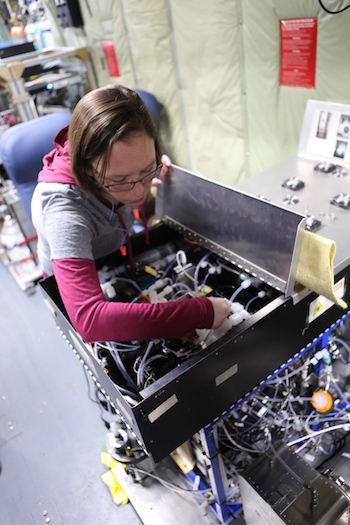2015 News & Events
Investigating eastern U.S. air pollution in wintertime
30 January 2015

We tend to think of summer as prime time for pollution – picture the haze that hangs over big cities on hot, steamy days. That's when increased sunlight and temperatures speed up chemical reactions that transform pollutants in the air into other "secondary" pollutants, including ozone, particulate matter, and others. But pollution doesn't cease at summer's end. Instead, the pathways to these familiar summertime pollutants are altered in ways that haven't been well studied and that therefore aren't well understood.
Beginning in February, a team of researchers, including those from the Cooperative Institute for Research in Environmental Sciences (CIRES) at the University of Colorado Boulder and NOAA's Earth System Research Laboratory (ESRL) Chemical Sciences Divison (CSD) in Boulder, Colorado, will join colleagues from the National Center for Atmospheric Research (NCAR) and several universities in an airborne atmospheric chemistry experiment to remedy this gap. "I'm not aware of any recent campaign that examined air pollution in winter, from aircraft, with state-of-the-art instruments," says José-Luis Jiménez, a CIRES scientist and one of the instrument's principal investigators.
Wintertime Investigation of Transport, Emissions, and Reactivity (WINTER) 2015 is a National Science Foundation (NSF)-funded, 6-week field campaign in the eastern United States that will take airborne measurements of atmospheric gases and particles that can affect air quality. From February 1 to March 15, scientists will use instruments on board the NSF/NCAR C-130 research aircraft, based at NASA's Langley Research Center in Hampton, Virginia, to sample several kinds of pollution sources in the mid-Atlantic and southeastern United States: large urban areas, coal-fired power plants, oil and gas extraction fields, agricultural or biofuel burning, and vegetation.
Though the researchers expect to see some familiar pollution-forming processes at work in the wintertime, they also expect differences. For example, winter's colder temperatures and reduced sunlight lead to a different mix of emissions than in summer, as agricultural activities shift and emissions produced by plants or animals are reduced. Instead, different trace gases almost certainly have larger, but unexplored, roles in wintertime pollution chemistry. "When we look at ozone chemistry in winter, the effects of pollutants on ozone production aren't as clear," says CSD researcher Steve Brown, one of two WINTER lead scientists.

The cold also slows down the chemical transformations in the atmosphere. This slowed chemistry means that the main drivers of air pollution in the summer, such as sunlight triggering ozone production, are only minor players in winter. According to Brown, "the slower processes at work in winter mean that primary emissions stay longer in the atmosphere, and disperse over wider areas as compared with summer, before they are removed by reactions."
The CSD and CIRES teams will operate three instruments on board the C-130 aircraft, to measure a suite of nitrogen-containing trace gases, ozone, sulfur dioxide, organic acids, and airborne particles. Other teams will measure several other trace gases and solar radiation. Together, these observations will ultimately yield a rich data set that will enable the researchers to decipher the wintertime chemical pathways that transform primary emissions (such as methane and nitrogen oxides) into secondary pollutants (such as ozone and fine particles).
CSD's Steve Brown and Joel Thornton of the University of Washington are the project's principal investigators. Brown and Thornton will share flight scientist duties, which include developing daily flight plans and working on board during flights with the pilots and instrument scientists to achieve flight objectives. José-Luis Jiménez of University of Colorado and CIRES, along with several other university colleagues, are heading up teams in charge of the various instruments on board the aircraft.
Ultimately, the findings from WINTER 2015 should help researchers better understand the impacts of wintertime processes on air quality and climate.
CSD scientists involved in the project are: Steve Brown (Principal Investigator), Patrick Veres (CIRES), Bill Dubé (CIRES), John Holloway (CIRES), Erin McDuffie (CIRES), Jim Roberts, and Dorothy Fibiger (NSF Geospace Sciences Post-Doctoral Fellow).